A 237-Hour Nightmare: Inside the Terrifying, Frostbitten First Ascent of Nepal’s Baruntse
Posted by admin on
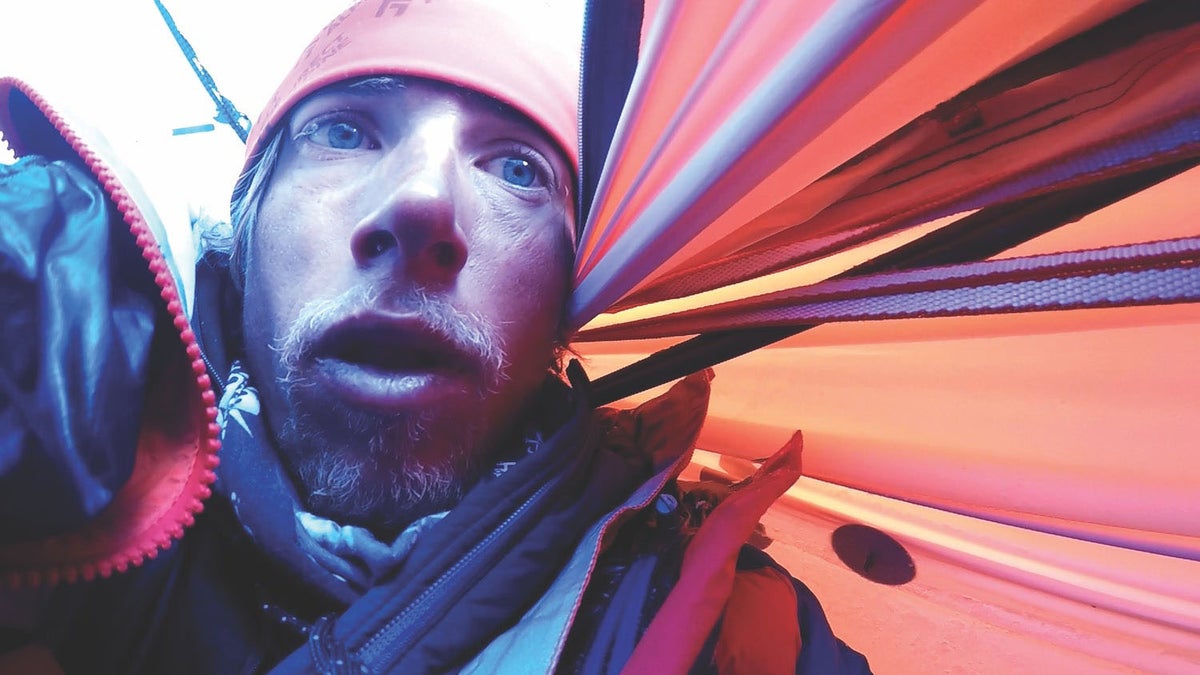
A special time. Another autumn, another winter, an approaching spring. Other problems in society, new concerns that have been kept idle until now, emerge like worms from holes. The pandemic future seems slightly drunk, a blurred image without clear contours. The year 2020 was a year I didn’t expect, one that swept away many plans, revealed weaknesses in certainty, and increased demands for improvisation and action. I’m not complaining, because for my nature, a certain amount of social chaos is a breeding ground where I thrive.
During the lockdown in Europe, I got to spend many months in the famous rocky areas of Italy and Spain, where crowds usually circulate. Suddenly there was quiet, sometimes interrupted by a playful wind stroking the rocks. My little daughter was also driven out of school, and her online attendance could be done anywhere, from any hole with an internet connection. We were not tied to our home in the Czech Republic and could instead zigzag across the continent.
My expedition plans to the big mountains, however, did not flourish, and I felt a great unease. Yet with the coming spring—2021—the snows began to melt on the slopes of the Himalayas, and Nepal’s travel ban began to lift. In the narrow gap when the gates to Nepal opened, my fellow Czech climbing partner Radoslav “Rad’a” Groh and I slipped through to attempt a new route on the west face of 23,497-foot Baruntse, an immense beast over a mile high.
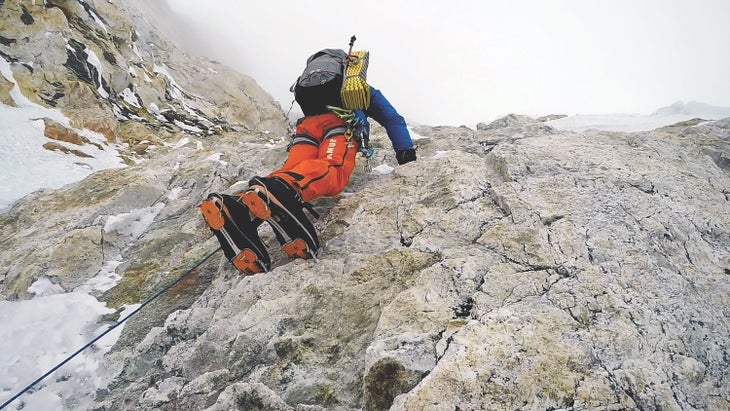
Kathmandu greeted me with the familiar, sweetish stench of the metropolis, although the city’s pulsing and swarming had disappeared with everyone staying home. We, however, were given no rest and had to step on the gas before our opportunity was revoked. I quickly sent Raďa and other friends who were trekking with us to Lukla, a Nepalese village about 30 miles south of Mount Everest, in advance. Then I underwent a martyrdom of sorts in Kathmandu, meeting with the ministry of tourism, who, for thousands of dollars, begrudgingly gave me a permit for the hill.
Permit in hand, I flew out of Kathmandu to Lukla. After the plane landed, I drank up two beers at the Paradise Hotel, then ran like a bloated goat with Raďa and friends into the heart of the Himalayas.
The next day on the trail, we met the accomplished Czech alpinist Honza Travnicek coming in the opposite direction. With him were the mountain conquerors Zdenek “Hacek,” or “The Hook,” Hak and Jaroslav “Banan,” or “Banana,” Bansky, who carried the first-ascent scalp from the north face of Nepal’s Kangchung Shar, all on their way back to civilization.
We spent the following days trekking toward base camp, a good acclimatization for Raďa and me. The mountain trail crossed several 16,000-foot saddles around Gokyo, then went over the nearly 19,685-foot pass of Amphu Labsta to the Hunku Valley. We hiked for 15 days through the Himalayas toward Baruntse base camp, reaching it on May 13. Under the mountain giant, there was absolute tranquility, with no other living souls, only a silence occasionally cut by the cracking of glaciers and the rumble of rolling scree and avalanches.
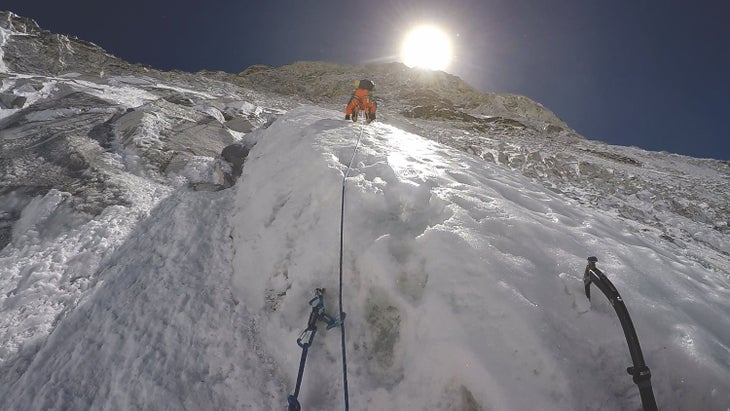
At base camp we dropped our packs from our bruised shoulders, set up camp, and passed the time scrambling among the lower peaks amid unsettled weather.
Just out our tent doors, we had our goal—Baruntse’s west face—before our eyes every day, whether I just half-opened the tent in the morning, went to the lake to brush my teeth, or watched the evening sun bathing the face a fiery pink. The majestic Baruntse filled the horizon, leaving no doubt as to who was master here.
I had thought about this giantess—a mixture of monstrosity and beauty—for years. From the first time I saw her in 2000, while on an expedition that made the first ascent of Kyashar, about ten miles southwest of Baruntse, I had looked for her weaker points and got a clear picture for a new route that would take the face dead-on, a centerline linking various ice and snow walls separated by rock bands that would likely be the crux.
Before Baruntse, however, in 2019, there was another mountain and a new route in the same valley with Zdenda Hacek: the demanding northwest face of Chamlang, where we climbed the 8,200-foot UFO (rated M6, WI). That route had been in my mind for 20 years, and, afterward Hacek and I agreed that it had been the hardest either of us had climbed. [Editor’s note: Holecek and Hacek received the Piolet d’Or for this ascent, adding to their Piolet for their new route, Satisfaction, in 2018, on 26,509-foot Gasherbrum I.]
On May 21, we got a satellite-phone message from our meteorologist friend and guardian angel back home, Alena. Our four-day weather window was on its way. My blood pressure immediately increased.
We packed gear and food for six days and set off for the face, sinking in deep snow on the steep approach glacier. Our first bivy was just below the beginning of the real climbing, hidden under an overhanging serac that would shelter us from any “hellos” that might swoop down from on high. Yet we knew that the glacier wasn’t entirely safe, that it was a frozen river in constant motion, albeit moving at a snail’s pace. If the chilled stiffness were to make a sudden move while we were under the serac, there would be nothing left of us but a greasy spot.
The following morning, we began to climb, our ice axes and crampons scratching the hard, ancient ice, as grating as nails on a chalkboard. My axes, even at the strongest swing, would hardly penetrate, and I chopped the thousand-year-old mountain coat into a million tiny pieces that fell onto Raďa’s head.
The west face had undergone a major change during recent drought years, with much of the snow and ice melting, leaving a hard shell that could withstand significant temperature fluctuations. Such desperate and lean conditions would make repeats of the 1995 Russian Route led by Sergei Efimov—a line up a pillar on the west face—impossible; at the current rate of warming, the Himalayas seem poised to transform into an overheated rock garden. Or perhaps it will get bloody cold again when nature decides so, and the hills will be covered in ice, as has happened numerous times throughout the history of earth.
The difficult terrain kept our pace slow, and we slowed further in several technical sections. Here, on the lower third of the mountain, we climbed around a tent dug into the ice by our friends Petr Machold and Kuba Vanek, who had disappeared on the mountain in 2013. We didn’t know if they were still inside or had been swept away by an avalanche.
Despite below-zero temperatures, sun rays loosened a stone here and there, and rock bullets carrying death rattled past us. After ten hours on the tips of our crampons and hammering with ice axes that bounced off glass-hard ice, we dug a small platform into a ridge of frozen snow shaped like a pipe organ and crawled into our tent, bivy-sack style since there wasn’t enough room to set it up. From a distance, we must have looked like a garbage bag with two puppets on a string. It was a desperate place where hardly two buttocks could fit, our legs hanging over the abyss. Observing that we had bivied several hundred meters lower than planned, I mentioned to Raďa that we would need to catch up the next day.
“Don’t worry, Mara, we will make it,” said the tangled bundle crouched next to me.
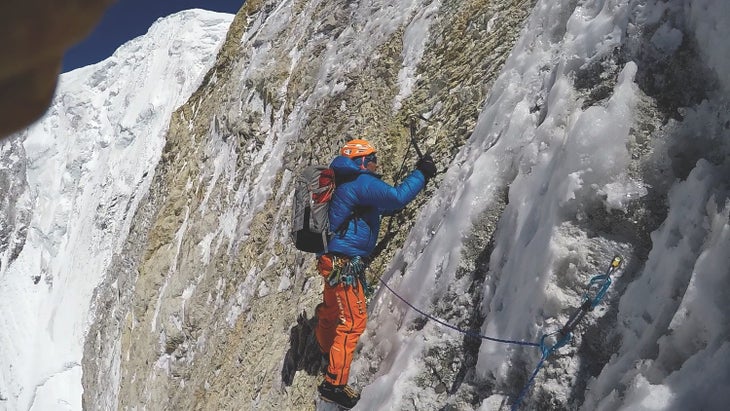
We woke to good weather, climbing an ice sheet that led us diagonally to the left over the snow organ. All day we threshed ice axes in hard ice, climbing between grooves separated by ribs of unconsolidated snow. The climbing was monotonous, tiring, and dangerous. My calves burned from fatigue, and my hands grew weaker with each blow of the ice tools. This section cost us a lot of energy, but we made up the previous day’s loss in distance climbed, gaining almost a full third of the face’s vertical elevation. In late afternoon, as the setting sun licked the wall, we found a pleasant surprise: a small space for the tent.
Our new bivy site, a snow rib formed by wind and frost, stuck to the wall like a swallow’s nest. Raďa and I stretched out to compensate for the previous night’s sleep deficit, hardly exchanging words. We fired up the stove and soon watered our parched throats with tea.
The next day, we encountered the most difficult passage of the ascent, a 750-foot barrier of broken rock, as layered and fragile as gingerbread. I placed a screw in a patch of ice. Protection on this section looked improbable, but I told Raďa I was going to play Russian roulette and go for it.
“OK, I am watching out,” he said. “Try to place a cam or pin in that mess, Mara.”
“Just watch out for rock, and I hope I won’t fall with it. I really wouldn’t like that,” I said.
The crux was made more difficult yet by a heavy snow that had begun to fall.
Snow rivers like white snakes crawled down the face, spewing a flurry of snowflakes. We climbed on, until the deteriorating weather demanded that we stop. Fortunately, again, we landed upon a rock promontory that jutted out over the valley and exactly matched the footprint of our tent. Our airy bivouac, our fourth on the mountain, didn’t have an additional centimeter of space on any side. Here we felt safe, although the basis of our sentiment was somewhat vague. We pulled out our sleeping bags, which had absorbed moisture and frozen into stones. Even so, it was better to lie inside them and become damp. I pulled out the satellite phone to find our daily weather report from Alena.
“Damn,” he’d texted, “the weather wasn’t supposed to change today; it shouldn’t have been getting worse until tomorrow afternoon.”
Alena’s message reinforced the point that nature comes up with its own strategies, regardless of man’s mathematical models. Empirical experience always reminds me that nothing is solid, clear, or unchanging, and we need to consider the variables in advance and prepare. In the mountains, you must accept change. It was true that we were half a day slower than planned, but that required only a minor adjustment, while the coming of this storm a day and a half earlier than predicted brought us closer by leaps and bounds to the troubles of the following days.
If, on the following morning, we woke up to the same poor weather, we wouldn’t be able to descend; the only way down was up. We would have to hope that conditions improved enough for us to climb a short pitch to the summit ridge overhead and then descend Baruntse’s right skyline ridge.
The sat phone beeped with another message from Alena: “Tomorrow the weather will be the same as today, and it will be getting worse significantly in the evening. From Wednesday—i.e., the day after tomorrow—onwards, the real shit begins.”
“Raďa,” I said, “we need to be superfast, make it to the ridge and rush over the summit, and descend with all our might. If Wednesday’s bad weather catches us at the top, we have a big problem.”
“Tomorrow we’ll shoot at lightning speed. I don’t want to be here for another minute, Mara,” Raďa replied.
We fell asleep in a fighting mood, readying ourselves for the next day.
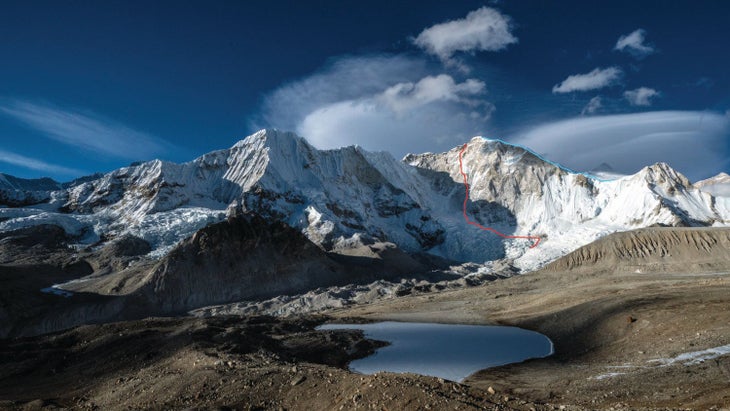
Visibility was poor in the morning, as clouds rolled in and snow continued to hammer, but we had to climb to the ridge, so close, just overhead. This we did, and we pressed on in the blizzard, encountering mixed sections that were slow, painstaking, and fraught with terror. After I led one harrowing pitch of rotten rock, Raďa climbed to me and muttered, “Shit, I wish it was all over.”
“It will be fine, just fine,” I said, not knowing whether I was kidding myself or not.
We reached the summit ridge and, completely frozen and covered with hoarfrost, were on top around 4 P.M. “We didn’t even take pictures, no expressions of joy,” I would text Alena that evening from our bivy. “We are very tired!”
Heavy fog made it impossible to see even one step ahead. We had no choice but to set up the tent just below the summit on the other side of the mountain and wait. As a consolation, I kept repeating to myself that the terrifying face was at least behind us, even though the storm was supposed to worsen the next day.
Darkness brought a strong wind, hammering snow against the thin walls of our dwelling with the brutality of gunfire. Every moment it seemed as if the tent would not withstand the onslaught, that the fluttering canvas was in its death convulsions.
By dawn, though the wind continued to rage, things grew quiet in the tent. Our nylon shelter had been buried in snow and was now an ice igloo. The space inside compressed to a minimum, and we couldn’t move. Even the air was stuffy and heavy. The tent was better than being outside, but we had to move the tent and break it from its casing or it would become an icy tomb.
We moved the tent about 300 feet lower on the descent ridge, performing the operation in the whiteout. Those few minutes outside seemed like an eternity. The cold wind sliced our wet-clad bodies. Then it took hours of shivering in the sleeping bags to rewarm ourselves. We lay next to each other all day without saying anything, our heavy thoughts best kept to ourselves. We knew that the weather wouldn’t abate for three days and could even get worse. We thought about the 72 hours we’d have to lie in these wet sleeping bags, unable to take even a single step, all on a ridge 23,000 feet high that was in places as sharp as a knife, with slopes falling more than a half mile to each side. That night the storm turned into a hurricane, burying the tent yet again.
Another day spent lying in the sleeping bags. It wasn’t until the seventh morning since we’d left the glacier, after two nights near the summit, that luck again smiled on us. Around 10 A.M., the wind finally calmed. Even the thick fog began dissolving. We hastily packed the tent, expecting to descend. Sunlight shone through a low wall of clouds, creating a diffuse, magical light that, for me, awakened a feeling of drunkenness. The light also had the effect of making it difficult to see, and I blundered around in the shimmering brilliance.
“Raďa, we can’t go on. I don’t see anything,” I said.
“But we must try to keep on going, or we’ll kick the bucket here, Mara,” he answered.
“I know it’s hard to accept,” I said, “but there’s nothing we can do—we have to wait. We can’t tell whether we’re going to fall into the valley with the next step.”
“Let’s give it one more try,” Raďa insisted.
“Shit, we don’t even know if we’re descending the ridge,” I countered.
Our discussion continued, soaked in tension. In the end, common sense prevailed. We had descended only 20 or 30 feet, but pitched the tent and crawled in to wait, this time for another two days and two nights as the storm raged all around us.
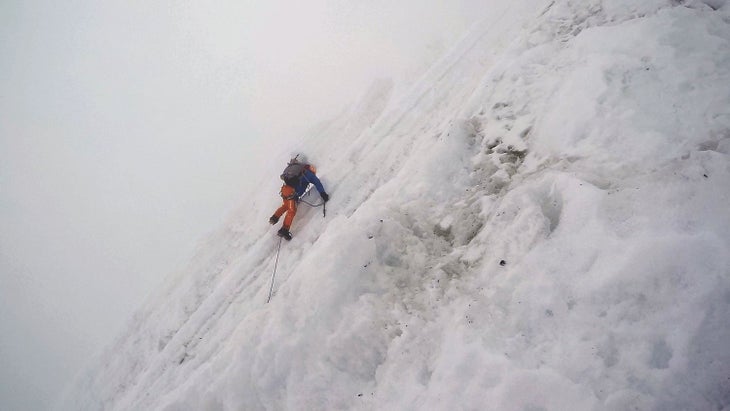
Frozen, exhausted, and increasingly depressed, we found that basic tasks, such as boiling water, required maximum effort. We constantly had to free the tent from the snow or forever be encased inside. We waited and prayed. There was nothing else to do. Our food supplies ran out. We had fuel to melt snow, but were out of tea.
On May 29, the weather calmed slightly. Finally, we could see. We began to descend the sharp ridge. Everywhere were drifts of fresh snow, creating funny, curled-up noses along the cornice edges. Even in steep sections, we sank in deep and unstable snow. We managed to downclimb a thousand meters until, in the evening, it became clear that we wouldn’t make it to the moraine that day, and thus our ninth bivouac was upon us. Our shared despair showed in our eyes when we looked at each other. We pushed back our emotions, stamped out a platform in the snow, and set up the tent in the saddle on Baruntse’s west ridge. When we laid out our sleeping bags, we discovered that they were as wet as if they’d been dunked in a barrel of water.
“Raďa,” I said, “if we get in these, we’ll get into trouble. If we haven’t got frostbite so far, we’ll surely be strong candidates in these bags.”
“Then let’s slip just under one sleeping bag together,” Raďa said, “and warm ourselves, tangled in each other.”
“Worth a try. I’m going to call for a helicopter to pick us up the next day.”
“Sure, give it a try,” said Raďa. “It would help us to the moon and back, because the slope to the glacier is just one big avalanche trap.”
“Hmmm, we’ll see.”
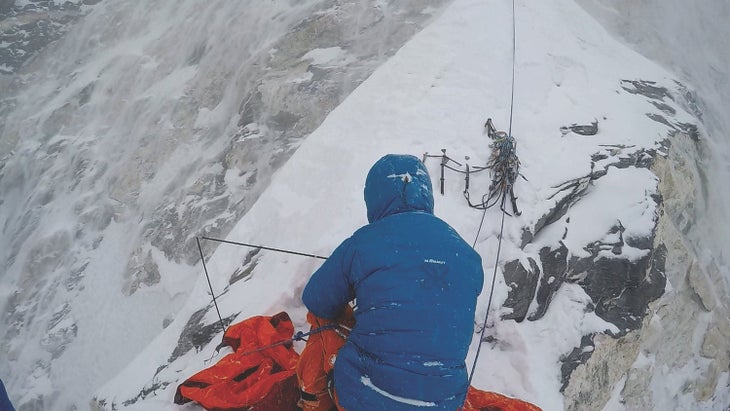
I dialed the satellite and in a hoarse voice explained the situation to Govinda Tamang of the Blue Sky agency, a friend I’ve worked with for a long time who provides my climbing permits in Nepal and who stays in touch with my wife while I’m on the mountain. He was glad to hear from us, relieved that we were alive. He said that he’d dispatch a helicopter in the morning, and that it was doubly necessary because base camp had cleared out and no one could reach us on foot due to the snowstorm.
The morning was crisp as the sun rose over Makalu, eight miles to the east. We relayed our coordinates to the helicoper pilot via the satellite phone—we had no desire to prolong our suffering or struggle with avalanches. In addition, the night had taken a toll: my feet were frozen, and two of my fingers tingled.
“How is it going with you, Raďa?” I asked.
“I don’t know yet, but for God’s sake, I wish the helicopter would pick us up. I don’t want to go any further,” he said.
At 7 A.M., the beating of propeller blades marked our liberation from our icy hell. In the chopper, we rose along the mountain wall that had been our home for ten days. At last I could relax, feeling the joy of an accomplished dream, but also waves of fatigue and the onset of pain throbbing in my frostbitten fingers. The machine floated like a dragonfly through the range, past Ama Dablam, Lhotse, Everest, Pumori, Kusum Kanguru, and other massive peaks on the horizon. In just 30 minutes, the helicopter retraced the journey that had taken Raďa and me 35 days. Just before we landed in Lukla, I turned to my partner.
“Thanks, Raďa,” I shouted over the booming noise of the rotor. “You were great.”
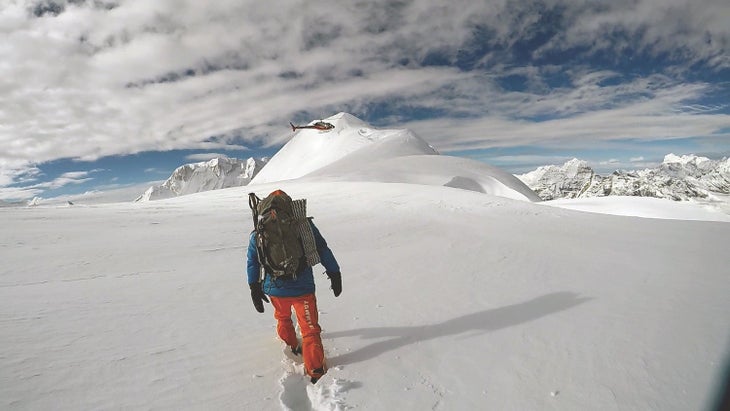
We called our route on the west face of Baruntse Heavenly Trap and rated it ABO+ (M6+ VI+ 80°), with 1,800 meters of climbing and 1,300 meters in elevation gain (5,905 and 4,265 feet, respectively), climbed from May 21 to May 30, 2021, to the summit at 23,497 feet. We dedicated the route to Machold and Vanek, who disappeared on the face in 2013.
I can say for myself that I have not done a harder climb in the mountains. I want to thank Radarek and the Almighty for their patience. It is thanks to them that this mountaneering gem was born.
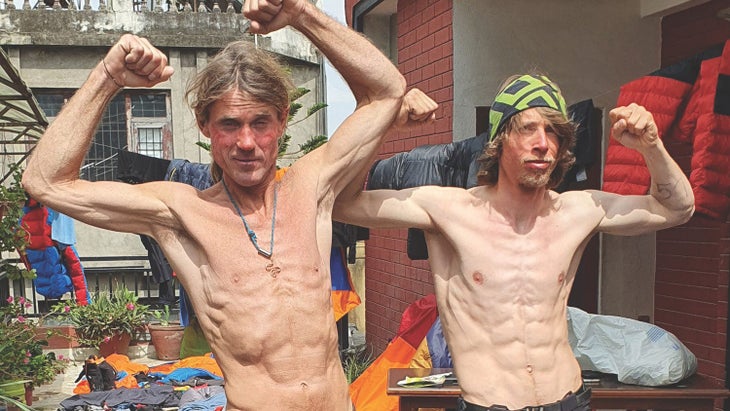
Marek Holecek, 47, is an accomplished Czech alpinist with over 40 expeditions and 16 first ascents around the world. He recently pioneered new routes up the southwest face of Gasherbrum I (8,080 meters) and Chamlang (7,321 meters), both with Zdenek Hak, for which he won Piolets d’Or in 2018 and 2020, respectively.
The post A 237-Hour Nightmare: Inside the Terrifying, Frostbitten First Ascent of Nepal’s Baruntse appeared first on Outside Online.
